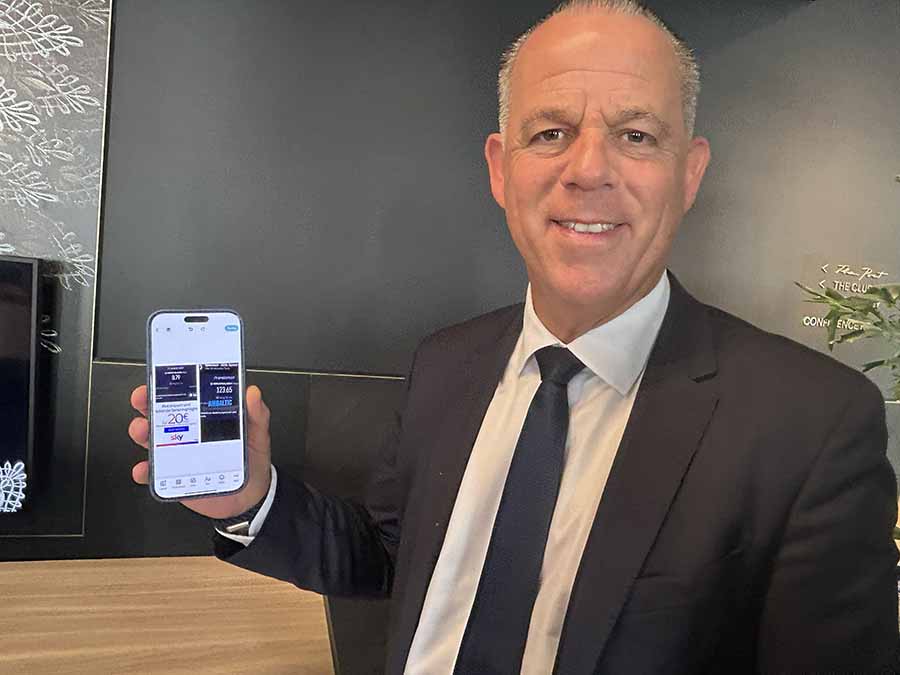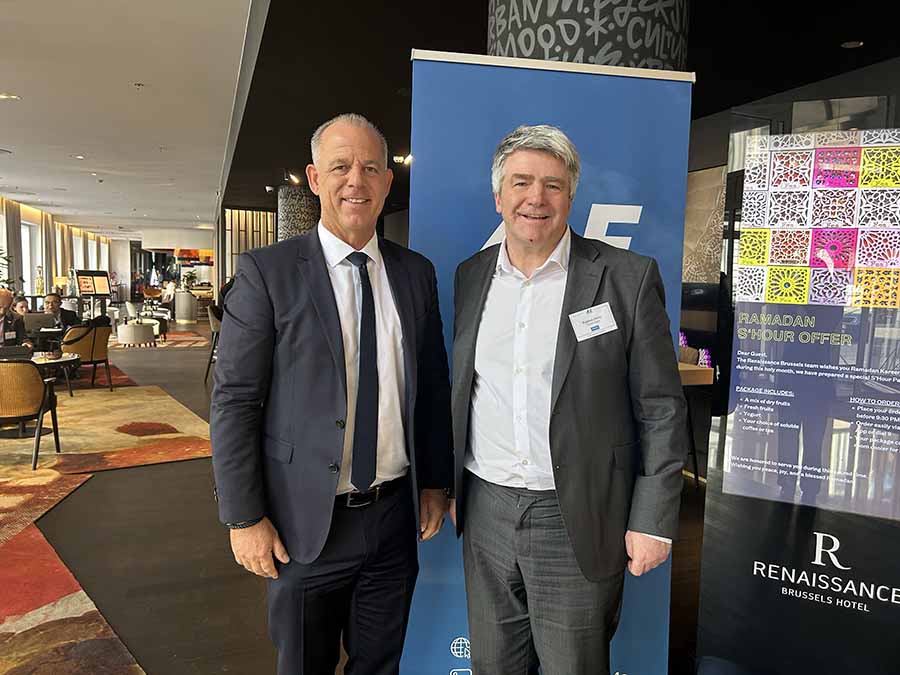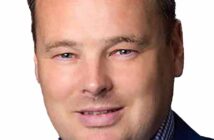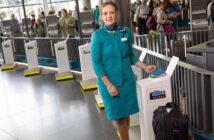
xAirBaltic plans to expand its fleet from 50 to 120 A220 aircraft as part of its future growth strategy.
The company aims to develop and utilise a wet lease model in collaboration with Lufthansa to enhance operational flexibility and profitability, in advance of a highly anticipated IPO this year.
Mr Gauss points out that environmental efficiency is achieved through the A220 aircraft’s minimal fuel burn and long range.
He describes AirBaltic’s introduction of free Starlink internet on select flights as a move that would revolutionise the passenger experience and differentiate its service.
With a growing market share in the Nordic and Baltic regions, AirBaltic is shifting focus toward expansion into the Nordics and exploring opportunities with wet lease contracts for its unique fleet of 15-seat A220s, including winter operations in South America.
Mr Gauss told Travel Extra in the margins of the A4E conference in Brussels: AirBaltic are the only airline in Europe which will double in size due to the order book we have growing from 50 aircraft to 120. That is the backbone of our equity story because we intend to do an IPO and raise money for that. And we expect in the hybrid model we have doing wetlease now with an exclusive contract with Lufthansa, combined with the scheduled service, that hybrid model is growing.
We are based from the Baltics starting growing in the Baltics but also stepping into the Nordics with a potential upside in the future, which is not calculated in is the reopening of Ukraine. I had a discussion with Michael O’Leary on this, on who will be first into Ukraine. So I said okay, let’s see.
That is an upside which is not planned. It would change a lot for us because we used to have Ukraine as a good market. If that wouldn’t come, then we see the forecast for growth in the Baltic states as a market. Latvia also went through two recessions in the past three years. In a climate which is not nice for any business we are growing and we see that as the base for our growth but also stepping outside to the Nordics. Everything north of Hamburg to the North Pole is a potential place where an aircraft could be positioned from this future aircraft.
Wet lease model
On the wetlease side we have this unique model where the aircraft flies, our aircraft in our colours, flies with our crew to Riga to Zurich then it goes on a sector for Swiss, Bilbao and back.
It is a Swiss operated wetlease and it returns back into our service and we rotate all 50 aircraft like this through the different airlines, which are all the Lufthansa group airlines and that works very well.
We have a very solid plan with the A220, produced for us in Mirabel, Canada, and with the usual couple of weeks delays we get the aircraft in as they are contracted so we do not see any issues with supply. We have 50 now and we get another 4 this year, 12 next year so the schedule is aligned and with these slight differences in deliveries.
We only have that aircraft type 150-seater, It’s an aircraft which is on the trip cost unbeatable in this category. There is nothing like this. It is one of the most efficient aircraft at all so if you look at environmental issues, we burn 1800 kilos an hour which there is no jet like this apart from a very small jet and it has a range of 7 hours which means we can fly Riga to Dubai without restrictions so the aircraft is fast, we do Riga, Tampere, Agadir, so we can fly very long sectors but we also use it to just shuttle between the Baltic states.
We change all aircraft that are maintained in Riga anyway, we bring them all through Riga base and in the future maybe some other bases which we have earmarked. The aircraft is rotating in and out. The crew is rotating in and out. We try to keep the crew for like a week, depending on where it is also longer, but ideally the crews do both because then they have the service quality which we require and then they get into.
This year we fly four Lufthansa groups, so Lufthansa, Austria, Brussels and Swiss. Last year it was just Swiss Lufthansa and there is other customers which we had before with SAS.
Starlink wifi
When it comes to the service, we have a net promoter score of 66, which is double the European average. We get feedback from the airlines we wetlease to that the passengers rate is very high. We just implemented Starlink, the first airline in Europe after three year lead time. We have it now on board on the first five aircraft and it is mind blowing That is revolutionary because this is something people have not seen before and we offer it for free.
In 2012 we ordered the aircraft and at that time there was already the question do we add Wi-Fi, internet connectivity and there was something from Panasonic available, you could have bought it and we said no because we don’t believe that that model would be a positive business case. And then we had on the agenda of the board each year.
So we looked at the business model and via SAT and whatever offers that, they said okay, we expect so much passenger uptake, they had the data, we expect you to earn this money from it and this is the prize for installation and so on.
We never believed in any of these business cases. When we started talking to Starlink it was us approaching Starlink and to say the idea we have at that time it wasn’t discussed because nobody had it. We want to give it for free, unlimited to the passengers, we don’t even want to have a login page, nor do we want to have their data. We want it to change the way because of the speed. We found a very nice partner there because they had the same idea at that time, they’re changing now.
The business case is very simple. You’re flying from Riga as a passenger to Lisbon, any route, you end up by mistake on our aircraft because you choose it and you had a good prize and you’re having that and everybody who has flown now with it would confirm what I say.
So you’re saying this is a different world, you have your 3.5 hour flight, you’re arriving and that’s it, flight is over. A couple of months later you have the chance to take another flight from Riga. You feel that this flight somehow is very different, especially for humans today, for you, for me, for young people. The third time you’re choosing to do a flight, you’re going to at least look what the price of that other airline was and if that price difference is not too big, you choose that airline.
There is no limitation. You don’t have to download your Netflix anymore, you just watch it on board. That is so new for people. All you do you go on the Wi-Fi setting so it’s really that simple. Once you are in the jetty boarding the aircraft, once you are on the stairs and from that moment on, you have it.
There is no login or any switch off and that makes a huge difference. This is a game changer which we will have as an advantage for a while but I think in the future this will become a standard high speed in the end of the world. For a while it’s a nice passenger upside.
What is the value of that for a passenger? We did a lot of research, so we have that number and we will just not add anything in the price. We will just in a normal way do our revenue management, this is the base, and then there comes the commercial case, which will come when we have a larger fleet equipped with it.
The third element is the operational cost savings because the pilots have iPads and they download all sorts of things before the flight like turbulence charts, then they fly and it’s not updated, but now you have everything live. When you talk to a technician, you just show on a FaceTime call, you show them what is happening, you need a doctor, all of these things become like a side effect on board payment, fraud check, it’s now real time, it’s not anymore than when you’re on the ground.
Upcoming IPO
We have done all the preparatory work, but we are waiting for the timing. The Latvian state made it very clear. They are a state and they don’t believe in state ownership. They would have gone out 2019 already, but COVID came. We were preparing for an IPO at that time. We need to do it in a now more difficult market environment because of what happens in the US and its volatile markets. But still the Latvian state is committed to 25pc plus one share, no more.
The Latvian government will stay as a strong shareholder, but not having the control. Lufthansa is in with at least 10pc or they could be technically diluted to 5pc. But then we have 65pc of mixed shareholders from international institutions, from local pension funds. But we will also have a large retail because we are very strong brand in the Baltic states. We are a growth story.
So we are basically like a startup. You invest now and then because we will not be paying likely, not paying dividends in the next years, but we are a growth story and that growth story is for some investors probably interesting. But we need to still say that we are announcing an ITF. We haven’t said that. And therefore we are very limited in what we can say about it. But the intention is clear and we want to do this and we say we do it as early as Q2, which means as of in three days, we might say it depending on markets. We’re ready to do it.
The consumer will not see a change apart from that we will offer more routes. But the rest for the consumer, so for the local taxpayers, for the Baltic people, they will become from a taxpayer owning it a shareholder, an investor. We have interesting ideas of what to do around that because it’s something which hasn’t happened the last 10 years and we think we can do something special on an IPO for the consumers, the local consumers. But otherwise the consumers will just continue getting new aircraft in, similar to Ryanair ,and the ultra modern aircraft and we keep our business model the way it is.
Competing with Ryanair
IIn Tallinn, we became market leader last year, and we just now increase. The last three years, we have increased the market share in all our home markets against the key competition, which is Ryanair in the region. That shows that the model works.
Ryanair is best in class. It is profitable. Everybody says they do it the best. If you can, in your markets, in all three markets, in all three Baltic states, take market share year on year against Ryanair, then we are doing something right.
It is not that we are cheaper or whatever. We have the right aircraft for doing what we do, and with that we can compete. On a route which, like London and Paris, we would never be able to compete volume-wise. Like there’s a nice example done by McKinsey, where they look at the Ryanair flight to Riga-Beauvais, and we flay Charles de Gaulle. They worked it works, the pricing they have on that route, if you value your time of less than €8 per hour. If you value your time less than €8 euro per hour, then you would be good in Beauvais. But otherwise you fly to CdeG. That’s why we are market leader on the route.
On top of it, we don’t have to carry 189 passengers, we only have 150 seats. We transfer people, which means they are not even point-to-point passengers. That helps. And then our aircraft doesn’t burn the same fuel. They need to fill the seats. Not everywhere in Europe will have connectivity to fill 189 seats.
I am not speaking against their model. I love it. Our costs go down over time as we grow with the fleet, but never to their levels. They do not need to, because while they have a lower CASK (Cost of Available Seat Kilometer), they also have a lower RASK (Revenue per Available Seat Kilometer).
So the game is, do we get our CASK still down or RASK up? We get our CASK down with increasing utilization. Because we came from three crises. COVID, war, we have a bigger war impact than others, and we have a crisis which is still going, if we analyze our CASK and RASK figures, we never had a normal year since 2019, since also last year we were in recession in the Baltics.
Not even now, because the war is still going on. So our first normal year is to come. But if you look at what we have done, and if you analyse the numbers, you’ll see, okay, that really makes sense in the way Ryanair do what they do. If you say we compare CASK with Ryanair, then you would say we cannot compete. The good thing is there is more airline models which work. Otherwise a Lufthansa would also not work. They don’t have the same CASK.
The Nordics
The Baltics is a small market. That’s why competition comes and goes. For Ryanair, all year round, it doesn’t make sense. Also the others, because their aircraft are too big. But the markets are growing, and they will also enjoy more routes from the Baltics, as the airline market will be growing according to forecasts by 3pc, while the rest of Europe grows by 1pc. If we assume that, then we still have a lot of room in the Baltics. Yes, we have stepped outside with Tampere, where we put an aircraft, and immediately became market leader because Finnair stopped flying.
And then there’s other cities in the Nordics, which is not defined. But any city in the Nordics has the potential that we say we replicate what we do from the Baltics. Because we only fly a hop in Riga, and that stays. But we fly from Tallinn and Vilnius, a point-to-point network, which works very well.
So we have a strong market, if you look at the perspective of growth for the Baltics, because we’re coming from a low base..
Closure of Russia
Russia was 15pc of total revenues at the time war was declared, Russia, Ukraine and Belarus. And it basically eliminated a very functional model of transfer east-west. That part was the best routes for Moscow and Petersburg. 12 times a day together with a lot of loading coaches. Really good, good routes. All gone.
Plus cost increase because we have to circumnavigate a lot of the routes. Plus GPS jamming and all this stuff. But it’s all priced in today. We do not need the Ukraine to open or Russia to come back because our model now is based without it. The upside would be if we have a airspace opening there and would be a huge upside because we would just be able to go back.
South America in winter
If you look at our financial reports it’s a high EBITDA margin business which we also want to grow and the beauty of this business is we are also looking at the South America now for the winter operation. We have some leads there that we can utilise the aircraft even better in this part of the operation. But the beauty is that if we look forward in the next years aircraft coming in we can dedicate the aircraft either to be in full schedule or give it to wetlease, if there is a seasonal demand for scheduled flying which there is in Europe. In summer it does this and, in an ideal world, for the winter season it flies in South America.




